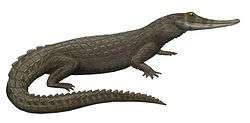Chalawan
| Chalawan Temporal range: Early Cretaceous | |
|---|---|
| Scientific classification | |
| Kingdom: | Animalia |
| Phylum: | Chordata |
| Class: | Reptilia |
| Superorder: | Crocodylomorpha |
| Family: | †Pholidosauridae |
| Genus: | †Chalawan Martin et al., 2013 |
| Type species | |
| †Sunosuchus thailandicus Buffetaut and Ingavat, 1980 | |
| Synonyms | |
|
? Sunosuchus shartegensis Efimov, 1988 | |
Chalawan (Thai: ชาละวัน, pronounced [t͡ɕʰāː.lā.wān]) is an extinct genus of pholidosaurid mesoeucrocodylian known from the Early Cretaceous Phu Kradung Formation of Nong Bua Lamphu Province, northeastern Thailand. It contains a single species, Chalawan thailandicus.[1]
Discovery and history
Chalawan is currently known solely from its holotype, a nearly complete lower jaw collected in the early 1980s from a road-cut near the town of Nong Bua Lamphu, in the upper part of the Phu Kradung Formation. This single specimen is the most well preserved vertebrate fossil that has been found from the formation; other vertebrates, including dinosaurs, are known only from fragmentary remains. This formation was originally considered to be Early to Middle Jurassic in age, however its age has been revised and except for its lowermost part which was probably deposited during the Late Jurassic, is now considered Early Cretaceous. The specimen was originally assigned to a new species of the goniopholidid Sunosuchus. Sunosuchus thailandicus was first described and named by Eric Buffetaut and Rucha Ingavat in 1980. The mandible is very robust, and its tip is spoon shaped and wider than the portion of the jaw immediately behind it. Buffetaut and Ingavat (1980-1984) noted that S. thailandicus shares features with both goniopholidids and pholidosaurids, and considered it an indication of a close relation between the two groups.[2]
Andrade et al. (2011) found S. thailandicus to be the only species of Sunosuchus, apart from its type species Sunosuchus miaoi, and possibly also "Goniopholis" phuwiangensis from Thailand, which they reassigned to Sunosuchus. Even though this was based on the results of the largest phylogenetic analysis available for mesoeucrocodylians, due to the fragmentary nature of the holotypes of S. thailandicus and "G." phuwiangensis these assignments were weakly supported.[3]

Halliday et al. (2013) tentatively synonymized "Sunosuchus" shartegensis (Efimov, 1988) as "Sunosuchus" cf. thailandicus. "S." shartegensis is known solely from the holotype PIN 4174‒1, a fragmented skull, comprising the rostrum, the preorbital region of the skull roof, the quadrates and parts of the quadratojugal, the occipital condyle and nearly complete mandibles. It was collected from "Layer 2" of the Tithonian (Late Jurassic) Ulan Malgait beds, in the Shar Teeg locality, of the Govi-Altai Province of Outer Mongolia, embedded in grey clay. Halliday et al. (2013) stated that "S." shartegensis shares some features with other species of Sunosuchus, and can not be differentiated from the holotype of S. thailandicus. Nevertheless, it lacks definitive synapomorphies of S. thailandicus, and possibly even these of Goniopholididae, suggesting that it might belong to a different species. Using an updated version of Andrade et al. (2011) phylogenetic analysis, Halliday et al. (2013) found "S." shartegensis to be the sister taxon of Kansajsuchus from Tajikistan. The addition of S. thailandicus (based on the holotype) to the analysis did not confirm the referral of "S." shartegensis to "S." cf. thailandicus, as it resulted in a large polytomy.[4]
An alternative generic name for S. thailandicus was proposed by Jeremy E. Martin, Komsorn Lauprasert, Eric Buffetaut, Romain Liard and Varavudh Suteethorn in 2013 following the discovery of cranial elements associated with the mandibular remains, creating the combinatio nova Chalawan thailandicus. The generic name is derived from the name of Chalawan, a giant in the mythology of Thailand that could take the form of a crocodile with diamond teeth. A premaxilla, among the newly discovered material, led to the reassignment of Chalawan to the Pholidosauridae. Additionally, Chalawan and both Goniopholididae and Pholidosauridae share the presence of a depression located on the lateral wall of the maxilla and jugal bone. Martin et al. (2013) first appeared online only several months after Halliday et al. (2013), therefore the influence of the newly discovered material on the taxonomic status of "S." shartegensis is yet unknown.[1]
See also
References
- 1 2 Martin, J. E.; Lauprasert, K.; Buffetaut, E.; Liard, R.; Suteethorn, V. (2013). Angielczyk, Kenneth, ed. "A large pholidosaurid in the Phu Kradung Formation of north-eastern Thailand". Palaeontology: n/a. doi:10.1111/pala.12086.
- ↑ Buffetaut, E.; Ingavat, R. (1984). "The lower jaw of Sunosuchus thailandicus, a mesosuchian crocodilian from the Jurassic of Thailand" (PDF). Palaeontology. 27 (1): 199–206. Archived from the original (PDF) on 2012-03-09.
- ↑ De Andrade, M. B.; Edmonds, R.; Benton, M. J.; Schouten, R. (2011). "A new Berriasian species of Goniopholis (Mesoeucrocodylia, Neosuchia) from England, and a review of the genus". Zoological Journal of the Linnean Society. 163: S66. doi:10.1111/j.1096-3642.2011.00709.x.
- ↑ Halliday, T. (2013). "A re-evaluation of goniopholidid crocodylomorph material from Central Asia: Biogeographic and phylogenetic implications". Acta Palaeontologica Polonica. doi:10.4202/app.2013.0018.

